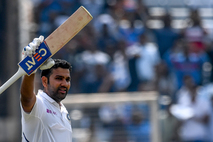 OPINION
OPINIONSouth Africa were beaten at their own game
Once upon a time, South Africa’s fast bowling line-up used to be a nightmare for batsmen across the globe irrespective of the conditions. Even while touring to dust bowls of the subcontinent, their pacers in the past were able to exploit the conditions even better than the pacers from the home side. To evaluate their potency, one only needs to look at the fact that the greats like Sachin Tendulkar and Rahul Dravid averaged in their thirties at home (their lowest against any opposition) while playing South Africa.
However, in the recently concluded Freedom trophy, the tables were turned. Except for the first morning of the third Test at Ranchi, South Africa’s fast bowlers were largely innocuous while the Indian fast bowling troika bruised their body and mind throughout the series.
The difference between the success of the pacers from the two sides can somewhat be attributed to the lengths at which they operated. On seamer-friendly pitches in South Africa, back of the length is potent enough to generate movement and bounce. However, the pitches in India require the bowlers to bowl further up to induce errors, an adjustment implemented by successful overseas bowlers in the past like Dale Steyn.

While the Indian troika was impeccable with their lengths, the South Africa pacers struggled to adapt. The difference between the proportions of length balls bowled by two sides was as much as 10 percent at the end of the second Test. During the morning of the third Test, they did improve and picked up three wickets in the process, but the difference in length balls at the end of the series still stands at seven percent.
To provide further context- Of the total 1,317 balls bowled by South African pacers throughout the series, 644 were length balls and 270 were back of a length balls. To match the proportion of length balls bowled by Indian pacers (56%), South Africa’s pacers should have bowled the 79 out of 270 back of a length deliveries further up to be a length delivery. That is 13.1 overs of missed opportunity to test the batsmen in the series. Delivered at the appropriate time – with the new ball or just after a session break, this might have made things a little less shambolic for the Proteas.


One of the key letdowns for South Africa was their spearhead Kagiso Rabada. Failing to match the fire displayed by his South African predecessors or his India counterparts, the most successful fast bowler of recent times in terms of balls per wicket (40.3) could do little to improve his numbers in the sub-continent. Until the end of the second Test, Rabada had only 43% of his balls bowled at a length while the Indian pacers went as high as 67% (Umesh Yadav).
Though it will be a learning curve for the Proteas, ‘outclassed by pace’ was not the bottom-line Faf du Plessis and his men would have expected at the beginning.
A headache relived (for the time being)
At the start of the series, one had to go back to December 2016 to look for a century opening partnership for India against a SENA country either home or away (against England at Chennai). Mayank Agarwal and Rohit Sharma ended a three-year drought in the first morning of the series. While Agarwal was an incumbent opener, Rohit’s credentials with the white-ball provided him with an opportunity to open for the first time against a red-ball.
What Rohit went on to achieve in the series, demands a literary piece of its own. The aspects of his batting that the record books will not glorify is the patience he displayed against the new ball, his judgment outside the off-stump, his defence and the use of soft hands early in the innings to ensure edges do not carry to the slip cordon.
After hitting centuries in both innings of the first Test, Rohit mentioned that he has been expecting this opportunity for the past couple of years and has been practising with a new red-ball in the nets since. It was probably this planning behind the scenes that made him appear tailor-made for the spot.
It is not just the runs but also the approach adopted by Rohit and Agarwal that will inspire confidence in the team management. Among all Indian openers since 2016 (with min 4 innings), Agarwal and Rohit are in the Top-3 with highest defensive shot percentage while facing pacers in the first 20 overs.
As the duo is untested in swinging and seaming conditions like the ones expected on damp wickets in New Zealand in February, it is too early to stamp them as a permanent solution. However, their mindset of respecting the new ball to capitalize later provides a fleeting relief to a chronic headache for the team management.